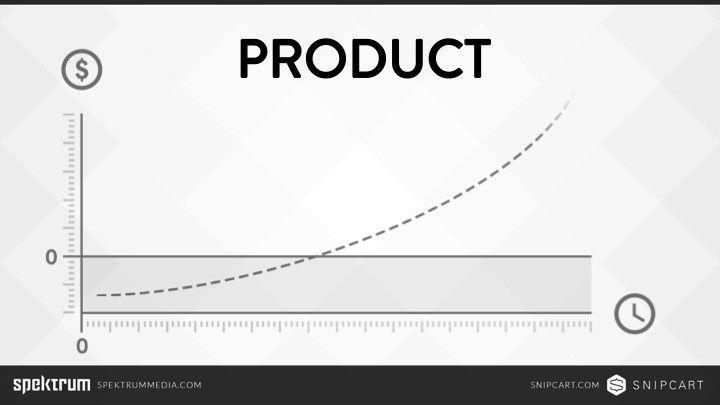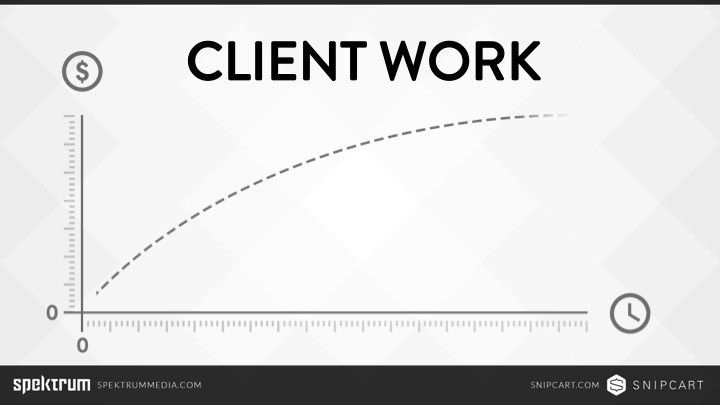Our odd startup: 3 ½ guys, no VC, profitability
Startups are scary.
Exciting, sure. But scary nonetheless.
Ask any founder who’s been up all night, obsessing over bugs, competition, funding, cashflow, or growth. Medium’s filled with their tales of woe.
When we launched Snipcart in 2013, I remember being scared:
“You’re going against Shopify. Or WooCommerce. That’s just stupid.”
“Nobody’ll pay 2% for a shopping cart they can’t even set up themselves.”
“Have you seen how crowded the e-commerce space is? You’ll never make it without funding.”
If I had a dollar for the number of times I told myself “Get the f*ck out of here, now!”, I could start my own VC firm.
Three and a half years later, however, I’ve finally overcome this crisis of faith. We went from making the rounds on Awwwards, Product Hunt, HackerNews, to quitting the events bandwagon and breaking even on a monthly basis. Looking how far we’ve come, I finally believe in our odd model.
Today, I want to take a step back and outline what we’ve done differently. To try and answer this question:
How are 3 ½ guys running a profitable SaaS in one of the most competitive markets?
I’ll touch on how we:
- Launched a product inside an agency.
- Made patience & profit core components of our company.
- Grew a developer-first product by betting on authenticity.
- Used “small” to our advantage.
Disclaimer: this isn’t a tale of hockey stick glory. It’s a tale of slow, grinding growth. However, in this fast-paced, growth-at-all-cost industry, I think it’s a tale worth sharing.
A business within a business: advantages, patience, & profits
Unlike many startups, our story doesn’t begin with side project all-nighters. Nor with garage code marathons. We launched our product within an established development shop. Spektrum, which had been building client software for years, acted as our initial service provider, incubator, and creditor.
They invested temporary resources (design, frontend) and a full-time salary (mine) into Snipcart, our developer-first e-commerce platform. At that point, Charles, our lead developer & a former Spektrum employee, partnered with them. He invested lots of his personal time to build the whole app, staying on active client duty at first.
Now, I understand this might sound counterintuitive. Product & client work are two opposed models, right?


The former makes money by selling self-serve, packaged solutions, while the latter bills hours. Product sells direct value and builds traction to be profitable (longer term). Client work sells trust and nurtures close relationships & repeat business to be profitable (shorter term).
So we were lucky that our relationship with Spektrum wasn’t creditor > debtor. It was more of an intimate partnership. After all, both companies shared almost all the same owners. So Spektrum didn’t mind reducing billable hours or re-injecting client capital into our shared product.
Here’s what this hybrid model allowed us to do in the beginning:
- Leverage a client case to build — and pay for — our MVP
- Minimize risks for all parties (Spektrum had development partially covered; Charles had a salary)
- Move faster without administrative red tape (handled by Spektrum)
- Keep our entrepreneurial freedom
The last one is paramount. The early Spektrum investments erased the need to generate capital extra quickly. We didn’t depend on VC money — we actually refused it a couple of times. Neither did we need to bring in early revenue to avoid bankruptcy. So no metrics to boost, no quarterly projections to meet, no urgent bills to pay. This hybrid model gave us a luxury most startups don’t have: time.
But it wasn’t all fun and games. While they helped with “micro-funding rounds” (e.g. a new website), Spektrum couldn’t spend tons on Snipcart: they had been profitable for years, and for their clients and employees’ sake, needed to stay that way. Our product manager, Georges, couldn’t yet make a full switch to Snipcart because he had whole other company to run (he’s our ½ guy).
If we wanted more team members, more features, and more customers, we had to rely on ourselves. We needed to generate results on our own, without increasing our debt towards the agency.
We got stuck in this… weird spot where most startups seemingly weren’t. We had to wait for revenue before hiring. We had to put on hold extra features, integrations and paid marketing initiatives non-essential to our business. We had to make our peace with not perfect, good enough, and not yet.
I remember Jason Fried writing about how “profit” is a feature of their company. Well I can tell you patience definitely became a feature of ours.
In a way, our model forced us to strive for profitability (unlike many). In leaving us with limited resources, it also forced us to become patient.
Most startups think it’s either A) bootstrap or B) get funding. We got out of the rat race and chose C), an uncommon combination of intrapreneurship & collaboration.
And C) came with a load of positive constraints that reframed our business journey. Which brings me to my next point:
Leveraging authenticity & smallness
1. Adopting a developer-first approach, with a marketing twist
In 2013, a Spektrum client asked Charles to add full e-commerce to an oooold website. There was no way in hell he’d touch that dusty codebase, and the client didn’t have the budget for a new site. So he figured out a way around it, by injecting a cart through JavaScript and creating products directly in the HTML markup.
We scratched our own itch and came up with a hackish solution. When we realized we weren’t the only itchy developers, we turned this into a product.
Our decision to push Snipcart as a developer-first product wasn’t the result of deep insights into the developer market. We just thought it’d involve way less bullsh*tting to sell something to people we understood.
Since Spektrum had failed at marketing its previous product, we all agreed that our first hire should be a marketing one.
So we were left with a small team and a peculiar bunch of interests: full-stack development, geek curiosity, Agile & lean management, copywriting, storytelling, and online marketing.
You might have heard the following from Srini Rao: be not the best but the only.
In a way, that’s exactly what we did. We competed differently, by leveraging our unique combination of skills inside our unique set of positive constraints (limited budget & resources to sell a niche, technical product). Luckily for us, such constraints are often the mother of startup innovation.
After failing to copy pre-made acquisition canvas, we eventually stumbled upon our content marketing “strategy”. It extrapolated our promise of a lean, modular e-commerce for developers who valued their tech stack freedom. We experimented ourselves with different toolsets, integrated Snipcart with it, built barebones demos for it, open sourced that code, and shared it with relevant communities. Eventually, we enriched this content strategy with helpful resources that weren’t only focused on our product.
It didn’t cost too much money or time. It drove traffic and signups. It leveraged all of our strengths and respected our constraints.
We put developers’ e-commerce concerns at the heart of our product and marketing. Within a “saturated” space, we were — and still are — having a different conversation, with different customers. Customers that are, for the most parts, devs like us.
Now let’s see how being small helped us do all that.
2. Using the power of SMALL and relationships
A while ago, I’d heard Josh Waitskin mention how scaling often dilutes quality and potency in companies. It was a foreign concept to me at first. I thought small was bad. Limiting. Three years in with Snipcart, I now see the good in small. And I feel compelled to share it:
- Our small budget forces us to find organic, sustainable acquisition channels. We have to take care of stuff ourselves. On a support and development level, this means we better understand our customers & product.
- Our small budget also pressures us to think through and often postpone important decisions (patience!). Since we cannot afford big HR or marketing faux-pas, we’re constantly reducing the scale and costs of our experimentation loops.
- Our small team fosters a smooth flow of information across all “departments”. Content marketing feeds into support and product development, and vice-versa. It also results in tight-knit relationships.
- Our small user base — we don’t need a huge one to be profitable — means we can connect more personally with users. Early on, this helped create product ambassadors.
Thanks to our small size and particular constraints, we were able to build a product, relationships, and growth model that just can’t be copied. At least not all at once. I firmly believe this is why we strive, despite all the competition out there.
Sure, there are now dozens of e-commerce solutions similar to Snipcart. Yet there is 0 business like ours.
So what now?
There are three important takeaways I want to leave you with:
- You don’t need to obliterate the incumbents in your market to make it. By solving a problem slightly differently, you can offer intrinsic value.
- You don’t have to copy “proven” models to make it. By leveraging your constraints and your strengths, you can build an authentic growth model.
- You don’t need tons of funding and a frantic growth rate to make it. You can build a sustainable business slowly, by growing at an organic rate.
It’d be easy to only credit our hybrid model, authentic approach, and small size for our success. Still, I feel like serendipity also needs a hat tip. When we first built our product, we did know developers were getting tired of closed e-commerce ecosystems and heavy platforms. But we didn’t know the API economy & frontend stack would explode this much. In an era that now champions a modular approach to development (see the JAMstack), a frontend, JS shopping cart platform sure is a great fit.
So, what do we want to do with Snipcart now? Keep building a sustainable, independent business? Sure. Improve our lives a little? Of course. Improve developers’ lives here and there? You bet. And that’s it. No changing the world. We’ve accepted that we’re only trying to make a dent in it.
In 2013, when we were wasting time pitching our startup all over the place, a friend told us:
“Snipcart is a cool idea, but it’s not a billion dollar-business.”
Looking at our bottom line today, I say we’re cool with that.
Yes, I’m still scared. The challenges we face as we scale really weigh in on me. Except now I’ve learned to love and trust this company. Because it resembles my own life a lot, you know: I got dropped in it without many instructions, I don’t always understand it, it’s hectic at times, never without a challenge, and filled with potential.
And above all, it’s the people in it that make it worthwhile.

Found this post valuable or entertaining enough? Take a second to share it on Twitter. Questions regarding our product, or our business? Drop a reply below. I’d love to keep the conversation going!
This post was first published on The Startup.
